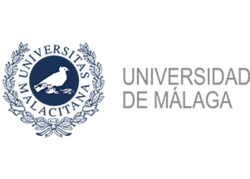University of Málaga
(University) | |
|---|---|
 | |
| Motto | Universitas Malacitana |
| Formation | 1972 |
| Headquarters | Málaga, Spain |
| Type | Public |
| Spanish university founded in 1972 | |
The University of Málaga (UMA, Universidad de Málaga) is a public university ranked 23 among all Spanish universities and 683 in the world.[1] It was established in 1972 and has, as of 2016, 30,203 Bachelor students and 2576 on a Master's program, 1255 tenured and 1056 temporary teachers. The UMA offers 65 degree courses and 6 double degrees, over 21 doctoral programmes, 64 master's Degrees, and 100 courses throughout the academic year. Education takes place in 18 centres by appointed teachers from 81 departments. The great majority of the teaching is organised within the two campuses, although classes also take place in locations spread around the city centre, as well as in Ronda and Antequera.
History
The history of the University of Málaga begins in 1968 with the creation of the Association of Friends of the University of Málaga (Asociación de Amigos de la Universidad de Málaga). This association sought the creation of the university because of the needs of the city (it was the only European city of over 300,000 inhabitants which did not have a university.) The University of Málaga was founded by decree of 18 August 1972 by grouping existing centers in the late 1960s: the Higher Polytechnic School (Spanish: Escuela Universitaria Politécnica) (1927), the Normal School (1846), the Faculty of Economics of the University of Granada in Málaga (1963) and the Seminar (1587).
At the time of its creation, the university provided the Faculty of Economics and Business and the Faculty of Medicine, which were created after the ratification of the decree. Its first location was the El Ejido Campus, along with several administrative centers around the city. UMA developed an expansion plan regarding fields of study and infrastructure. Thus, once established in El Ejido Campus, the University expanded towards the western district of Teatinos, an area that initially comprised the School of Medicine, the School of Humanities, and the School of Science, and gradually developed into a whole campus providing a full range of academic studies and services.
An Alumnus on Wikispooks
| Person | Born | Nationality | Summary | Description |
|---|---|---|---|---|
| Bernardino León Gross | 20 October 1964 | Spain | Diplomat | Spanish diplomat specializing in the Arab world who attended all Bilderbergs from 2006 to 2011 |